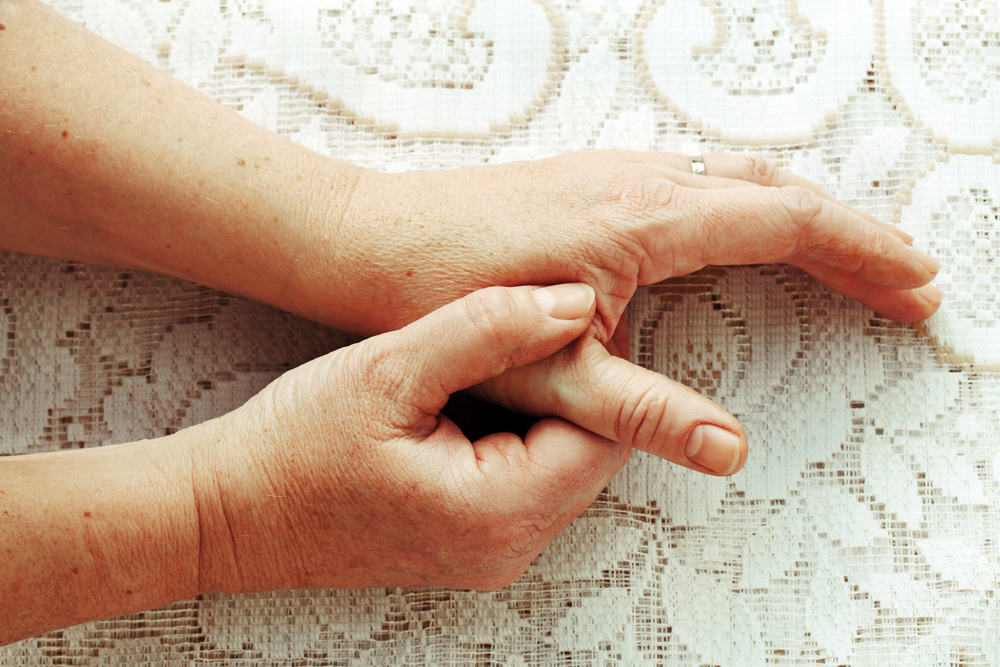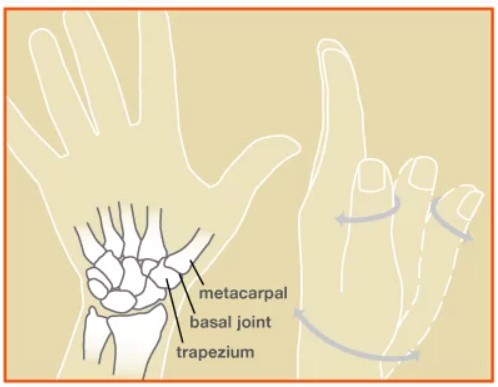Thumb arthritis is very common. About 15% of women and 7% of men have symptoms of thumb arthritis. This condition can cause pain, weakness with grip and pinch, difficulty opening jars, and reduced quality of life.

The human thumb is unique. We can move our thumbs to touch the small finger in a motion called thumb opposition. This mobility occurs at the basal thumb joint, called the thumb carpometacarpal (CMC) joint. This joint allows us to pinch with precision and grasp with power, perform fine motor tasks and use tools with strength. We use our opposable thumbs for just about everything in daily life. Unfortunately, this wear and tear can take a toll on the thumb and result in osteoarthritis. By the time we are in our 50s, about 50% of people have signs of thumb CMC joint degeneration on x-rays. If we reach our 90s, almost 100% of people have osteoarthritis on x-rays. This observation has led some physicians to conclude that the only certainties in life are death, taxes,…. and thumb arthritis.

How do we treat thumb arthritis without surgery?
There are many ways to treat thumb arthritis non-surgically. While no one can turn back the clock of time, and no one can cure osteoarthritis (yet), there are many ways to reduce the symptoms of arthritis. These options include braces, hand therapy, oral and topical medications, injections, supplements, lifestyle modifications, and mental health treatment. Reducing pain, improving hand function, and improving quality of life are the main goals of treatment. Continue reading for more detailed information.
Braces for thumb arthritis
There are several brace options for thumb carpometacarpal osteoarthritis. Off-the-shelf, or prefabricated, braces are available for the basal thumb joint. These products come in a variety of materials, shapes, and sizes. The main goal of a brace is to comfortably support or immobilize the inflamed joint. Patient preferences vary on which type of brace is the most helpful. Custom orthoses are also available and are made by a hand therapist specifically for a patient’s hand. I recommend using a thumb brace during sleep at night and only during an activity which brings on the symptoms. There are many studies showing benefit with use of a thumb brace for osteoarthritis.
Hand therapy for thumb arthritis
Hand therapists can help patients in several ways. First of all, therapists can provide education about this condition, teach patients about joint protection, and show examples of assistive devices to be used around the house. Additionally, therapists can fabricate a custom brace to suit the needs of each patient. Furthermore, therapists can teach an exercise program to improve thumb range of motion, strength and stability. A newer exercise program is called dynamic stabilization program for thumb carpometacarpal osteoarthritis. These sets of exercises are designed to strengthen the supportive muscles around the thumb basal joint to reduce joint subluxation and pain. One or two hand therapy sessions are typically sufficient to instruct patients in this home exercise program. There are many studies demonstrating the benefit of hand therapy in patients with thumb osteoarthritis.
Oral medications for thumb arthritis
Oral non-steroidal anti-inflammatory drugs (NSAIDs) are commonly used to treat osteoarthritis symptoms. These include ibuprofen, meloxicam, naproxen, celecoxib, and diclofenac, among others. The medications work by blocking specific components of the inflammatory cascade to lower inflammation in the body. These medications are best used sparingly or under the supervision of a primary care physician due to side effects including kidney disease, gastrointestinal bleeding, and cardiovascular complications.
Acetaminophen is another commonly used oral medication for osteoarthritis, known by the brand name Tylenol. This medication can reduce pain but does not have the same anti-inflammatory effects as traditional NSAIDs. Liver toxicity is a concern with acetaminophen doses greater than 3000 mg in a 24 hour period. Systemic side effects limit the use of oral NSAIDs and Acetaminophen. Patients are advised to follow the manufacturer’s instructions included with these medications.
Topical medications for thumb arthritis
Topical medications are also available for thumb arthritis and have become more popular lately. Since these medications are absorbed locally through the skin, there is much less risk of systemic side effects when compared to oral medications. 1% Diclofenac gel is available without a prescription, and has been shown to reduce thumb arthritis pain significantly in some studies. Patients are advised to follow the manufacturer’s instructions included with the medication.
Topical cannabidiol (CBD) has been studied for treating patients with thumb osteoarthritis, and the results have recently been published in the hand surgery literature. When used short term, this topical medication was safe and effective to reduce thumb pain in most patients. CBD products are derived from the cannabis plant in the marijuana plant family. CBD products with very low levels of THC can be purchased legally in most US states, but state laws vary currently.
Food supplements for thumb arthritis
Nutraceuticals are a multi-billion dollar industry today. People are increasingly searching for alternatives to traditional NSAIDs and prescription medications for arthritis due to the concern for side effects. These products are derived from food sources and are available over the counter. The manufacturers make various health benefit claims about their products. However, most of these statements have not been reviewed or verified by the Food and Drug Administration (FDA). There are still many unknowns about the efficacy and safety of many nutraceutical products for patients with thumb osteoarthritis.
One food supplement which has been studied extensively is turmeric. This spice in the ginger root family has been used in Asian cooking as well as Chinese medicine and Aruyvedic medicine for thousands of years. The active ingredient curcumin has been shown to have anti-inflammatory properties similar to some NSAIDs. This can be purchased in a capsule form or used as a powder in seasoning food. Patients who take blood thinners should be cautious, as turmeric in high doses can increase bleeding risk.
Injections for thumb arthritis
Corticosteroid injections, also known as cortisone shots, are commonly used in treating patients with thumb carpometacarpal osteoarthritis. These injections reduce inflammation in the joint and can reduce pain significantly for most patients. On average, the injection effects last between 3 and 6 months. Injections should be used sparingly because high dose and frequent injections may result in damage to joint cartilage and surrounding soft tissue structures. Image-guidance with fluoroscopy or ultrasound is available to assist the doctor in administering the injection, but this is not necessary to achieve consistent pain relief. Various steroid formulas are available for injection, and no particular brand has been shown to be superior.
Stem cell and platelet rich plasma injections for thumb carpometacarpal osteoarthritis are currently considered experimental and are not reimbursed by most health insurance companies. Study results are mixed about the effectiveness of these alternative injections.
Lifestyle changes for thumb arthritis
The typical diet in the United States today includes a significant amount of carbohydrates, sugar, highly processed ingredients, and unhealthy fats. This combination has been shown to increase systemic inflammation. Patients seeking to reduce inflammation through dietary measures should consider consulting with a nutritionist or primary care physician to make appropriate changes. Weight loss and improved cardiovascular fitness can improve outcomes in patients with knee osteoarthritis, but it is not known if these modifications are also helpful in thumb osteoarthritis. Smoking is also an independent risk factor for increased musculoskeletal pain. Tobacco users should be encouraged to seek resources for quitting to improve their pulmonary, cardiovascular, and musculoskeletal health.
Does mental health contribute to thumb arthritis pain?
Yes. Pain is an unpleasant physical AND emotional experience for patients. It is important to realize that the pain we feel has BOTH a physical and an emotional component. Just as the severity of a physical injury can influence the pain intensity, the condition of a patient’s mental health can also influence the pain intensity. Our brains process the sensory signals we receive throughout our bodies, and this process can be modified by our mental health to increase or decrease the pain we experience. It has been shown in many studies that patients with untreated depression and anxiety have higher levels of hand pain and dysfunction. Treatment of mental health conditions may significantly reduce thumb arthritis pain and reduce the need for surgery. Most hand surgeons are not trained in diagnosing or treating mental health conditions. However, a referral to a primary care physician or mental health professional may be beneficial.
Do I need surgery for my thumb arthritis?
Some orthopedic surgeons say that the arthritic disease inevitably progresses to the point where operative treatment becomes necessary. This opinion is not supported by the overwhelming evidence in the medical literature. The majority of patients with thumb CMC joint osteoarthritis do not require surgery. If a patient has tried various nonsurgical treatments for at least six months and the symptoms are still intolerable, thumb arthritis surgery should be considered.
Which thumb arthritis surgery is the best?
There is still debate among hand surgeons about which thumb arthritis surgery is the best. Each type of surgery available has its unique risks and benefits. Most randomized, controlled trials and systematic reviews of comparative studies do not show a clear superiority of one technique versus another.
When should I see a hand surgeon for thumb arthritis?
Just because we are called “hand surgeons” does not mean that all we do is hand surgery. As you can see from this article, there are many nonsurgical treatment options available in a hand surgeon’s office. Any time a patient wants to learn more about their thumb condition or their treatment options, they should consult with a hand surgeon.
Nonsurgical thumb arthritis treatment is available
If you are in the Raleigh, North Carolina area, consider consultation with hand surgeon Dr. John Erickson or one of his colleagues at the Raleigh Hand to Shoulder Center.
